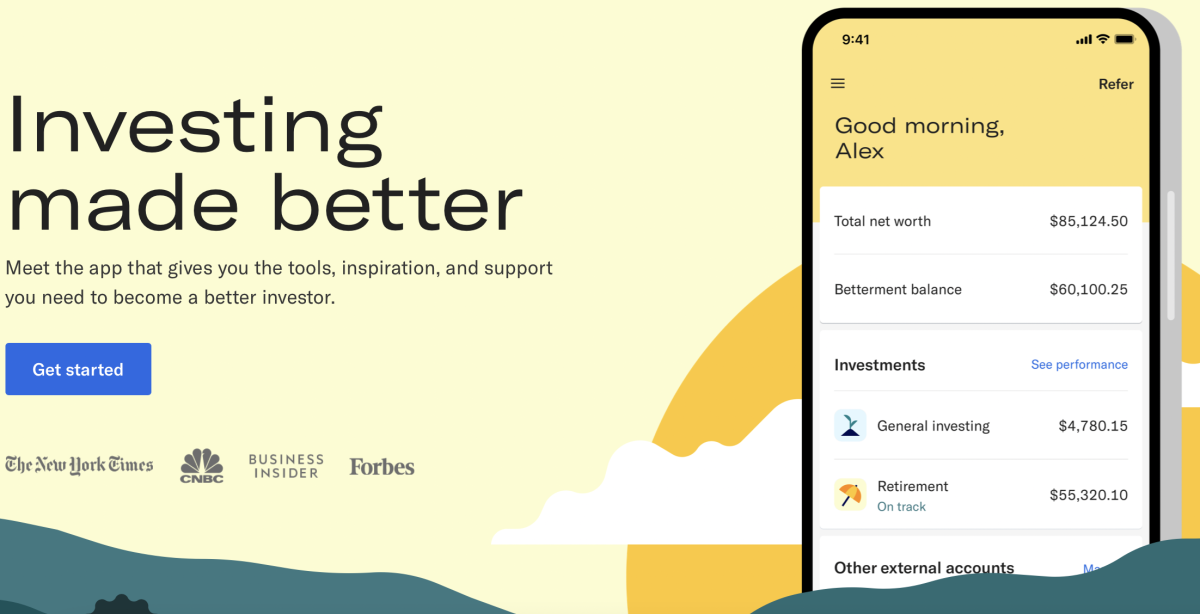Investing is now cheaper than ever, with many online brokerage firms offering zero to very low commission services. Online investment platforms are agile, convenient, and in most cases, safe.
Online investment platforms allow you to capitalize on the market potential of the US and other economies by investing in your preferred asset classes regardless of where you’re located.
Here are eight super cool apps you can use for investing in US stocks and ETFs.
Ally
Ally is about auto-investing in expert-curated ‘Robo-portfolios’ starting with as little as $100.

The platform levies no advisory, rebalancing, or annual fee for cash-enhanced portfolios. These portfolios typically have 30% cash (not FDIC insured), which acts as an interest-earning buffer should the market crash.
But Ally also features market-focused portfolios for investors with fewer cash holdings. However, such accounts will attract a 0.30% annual advisory fee charged monthly. In such cases, 2% of the portfolio is held as cash.
While you can always opt from the pre-defined portfolios, Ally also supports customizations per the user’s risk and return appetite.
The platform permits opening individual, joint, and custodial accounts, in addition to traditional, roth, and rollover IRA for long-term investment goals.
As a Securities Investor Protection Corporation (SIPC) member, Ally’s investor funds are covered with a $500k insurance policy, including a maximum of $250k in cash claims. Besides, investors are protected with an additional insurance policy worth $150 million should the claims exceed the SIPC limits.
M1 Finance
M1 Finance started as a robo-advisor has grown into a one-stop solution for all your personal finance-related needs. The platform allows you to borrow money or invest it in individual stocks, ETFs, and REITs.
Need to diversify your funds? No sweat. M1 Finance has what it calls the Pie dashboard, where you can manually choose from 6,000 available funds and stocks. You can also access the 80+ expert-curated pies, each with a different investment strategy. It’s easy to automate investments on the platform. Putting investments on autopilot is an excellent discipline strategy when you’re starting.
M1 Finance doesn’t charge any fees or brokerage charges on its services. However, the platform isn’t geared towards seasoned traders. If you want an app with all the bells and whistles, you’ll need to look elsewhere. An M1 Finance account is ideal for small to medium investors looking to automate their investment process and those who want to customize and diversify their portfolios.
Robinhood
Robinhood was launched in 2013, and so far, it has managed to garner a 22.4 million-strong user base. The mobile application and website are built with an easy UI, allowing the creation of a new digital account seamlessly and with no inactivity charges.

The platform doesn’t require you to maintain a minimum balance, and you’re free to invest as little or as much as you prefer. Robinhood is also a commission-free platform that allows you to invest in US stocks, ETFs, options, and cryptocurrency.
However, you can’t invest in mutual funds and bonds or integrate your retirement fund with Robinhood. Another downside of Robinhood is that it lacks the educational resources you might need before making an educated, well-informed investment decision.
For this reason, Robinhood is better suited for those who can research themselves and then use the app to deploy funds as per their research.
Acorns
Acorns aim to automate the micro-investment space. With a simple UI and a list of helpful saving and investment-focused products, the platform has a user base of more than 6.8 million.

So, how does Acorns work?
Well, Acorns goes all-in on helping investors with discipline. It rounds off all your purchases to the nearest dollar and sets it aside for investment. You also have the option to set aside a greater multiple of the set aside amount, though.
For instance, if you buy a $2.5 burger, Acorns will set aside 50 cents (or a multiple thereof) from your account for investments. But that’s not the only way to invest with Acorns—you can also make deposits on the go. You can also use the robo-advisor that allocates your funds based on a curated investment plan.
With beginner-friendly educational resources, Acorns is an ideal platform for beginners. As a starting point, you can input your age, income, and financial goals into Acorns, and it will determine your risk appetite. Once you know what your risk appetite looks like, you’ll be in a better position to make investments.
That said, the $3-$5 monthly fee on small accounts can be expensive to some users.
Webull
The clutter-free interface of the mobile app and the website make Webull appealing to the new-age investors. But the platform is also armed with technical tools for expert traders—it offers a comprehensive set up for investing in stocks, ETFs, ADRs, options, and cryptocurrency.

However, Webull doesn’t have an information-rich resource center. If you’re new to investing, the candlestick charts might feel a tad overwhelming without any information available on the platform. Webull is more suited for intermediate to expert level investors, who already understand the market to some degree and have some investing experience.
Webull doesn’t charge a brokerage commission or inactivity fees, but if you want to transfer assets to another platform, there’s a flat $75 transfer fee.
Questrade
This Canadian stock trading platform allows you to make self-directed investments in stocks, ETFs, Forex, options, and mutual funds. The app and website are designed with a simple and beginner-friendly user interface.

We love the fact that Questrade has a dedicated ‘Learning’ tab where you can keep a tab of the markets, track your goals, understand how to use the platform better, and gain insights into the basics of investing.
Questrade is an ideal option for those who want to avoid the hefty charges that banks levy on investments. The commissions on stocks can be as low as CAD 4.95—a far better deal than other Canadian brokers.
The screener is pretty basic, though, and doesn’t provide any advanced statistical data on stocks. Plus, it also charges a no-activity fee of CAD 24.95 on small accounts, but that could be an excellent way to maintain your consistency.
Also read: Best Stock Screeners to Narrow Down Your Investment Choices
Betterment
Betterment is a no-fuss robo-advisor platform that allows you to choose from several ETFs that track 13 diverse asset classes.

Here’s what we like about Betterment: It has a ‘Flexible Portfolios’ feature that helps you rebalance your ETF investments whenever you believe there has been a fundamental shift in the economic environment. The available portfolio types include high-beta, income, and socially responsible. Once everything is set, you can use the ‘Planning’ tab to track your goals and plan your retirement.
A management fee of 0.25% is applicable on the base plan. Upgrading to the Betterment Premium plan will cost 0.40% of assets, with a minimum account requirement worth $100,000, where you’ll have access to a Certified Financial Planner.
SoFi
Primarily a student refinancing company, SoFi is also a trading platform targeted at new investors with small portfolios. You can choose to automate investments using the 10 pre-curated portfolios, or you can proactively deploy funds and manage your investments if you’ve dabbled as a trader before.

There are no management charges for automated or active trading. Plus, you also get access to a certified financial planner without paying anything extra. The app is not meant for advanced investors, though.
Wealthfront
Wealthfront has revolutionized the automated investment space while also catering to active investors and traders. It has both an app and a web-based tool that are equally functional and user-friendly.

The Wealthfront robo-advisor attempts to analyze your risk appetite based on your inputs and suggests portfolios that align with your risk profile. It’s more than just a financial planning tool, however. It also has a portfolio customization tool that allows you to craft and rebalance your portfolio based on your analyses.
There’s a minimum account requirement of $500 on Wealthfront, with a management fee of 0.25% of assets. However, if you’re looking for something more cost-effective, there are better options out there.
Palabras finales
Whether you’re just starting your investment journey or you’re already a seasoned investor, you should always assess if there are more effective and pocket-friendly platforms out there.
We’ve listed some of the best investing apps out there. You will now be able to pick one and get started with your investment journey within minutes.

